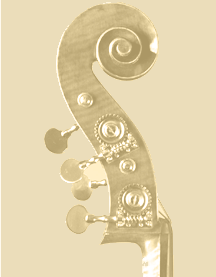Why use Gut strings on an upright bass?
While there are only a few symphony orchestra players that play
on gut strings today, these are still popular strings in the
other genres of music circles. Whether it is a Jazz player
that wants the 'old' original sound that they hear from the
1950's or early 60's recordings, a bluegrass player that likes
that warmth and above all else, the Rockabilly player that wants
the super easy tension that guts offer. Gut strings can really
change the playing technique of the player and also change the
character and response of the instrument.
Lenzner is the top German string manufacturer that
is so good at what they do, they also make gut strings for other
name brands as well. The Lenzner brand bass
strings are the finest quality and they are the most affordable
gut strings out there. Even so, we still pride ourselves
here with the best quality and lowest prices on them. To see our
selection of these strings, please visit the new,
Lenzner Bass Strings page.
A note about gut care and installing new gut strings on your
bass: In general gut strings have a much wider diameter
than regular metal strings. For this same reason there needs to be
some accommodation made in the nut slot (near the scroll) so that
the string will be able to slide through it easier. Usually a
wider groove is needed and also don't forget to take a pencil and
rub hard in that groove to lubricate the slot.
On the gut strings that have a heavy winding (like the wound E or
A) the winding tends to bind up in the slot. The person
tightening and tuning up the new string, sometimes doesn't realize
that string is caught in the groove and he keeps tightening until
the string breaks right at the nut or the tuning peg. So in
fact, for a while they were only tightening the span between the nut
and peg....breaking that string. Also lube up the bridge slots
too. They will bind just the same.
- make a slightly bigger groove to fit the new fat string
(especially on the E and A wound)
- rub the graphite pencil tip into each groove before
installing new strings
- watch that string (in nut slot) as you tune up to make sure
that string is sliding through that slot as you're tuning that
loose string for the first time
- occasionally, loosen these strings, every few months, and
re-lubricate that slot again with the pencil as the re-tuning
will diminish the original graphite
- Also, keep an eye on the bridge tip to make sure that your
bridge (bottom side) remains perpendicular with the top.
Sometimes the winding will bind in the bridge and pull the tip
of the bridge upwards towards the fingerboard. This will
quickly warp your bridge if it remains tilted like that for too
long. Every once in a while sight along the angle of the bridge
and pinch the tip back down if you see it slanting up again.

Caring for gut strings. Gut being the natural fiber
that it is, will dry out easily. Going from humid to dry
or dry to humid, will cause the winding or fibers in the string to
be more susceptible to drying out or stretching. Pirastro
sells little bottles of gut string oil that will greatly help in the
upkeep of the strings, replacing the natural oils and keeping them
from premature drying and/or wear. These bottles will last a
long time. To order one, go to our
upright bass accessories page 2.
Got a question about
string choices?
Email us
or call Steve at 800-600-2689. |


